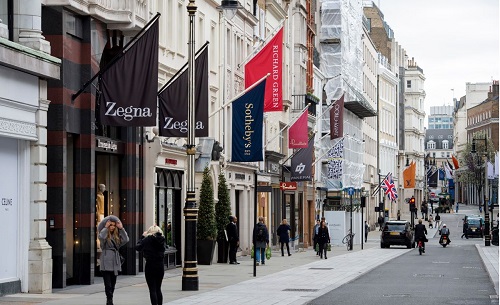FW
Ramesh Poddar, Chairman, Siyaram
 “Definitely there is an opportunity for India as everyone will look for an alternative source. Hence, if we are able to exploit this chance, then definitely there is a possibility for India to be the next sourcing hub. China on the other hand has the advantage of bulk production and to get that kind of advantage and to come to their cost structure will take time though our labour costs are comparatively the same and the advantage they have is of mass scale production. I feel India should take this challenge and fill the gap.”
“Definitely there is an opportunity for India as everyone will look for an alternative source. Hence, if we are able to exploit this chance, then definitely there is a possibility for India to be the next sourcing hub. China on the other hand has the advantage of bulk production and to get that kind of advantage and to come to their cost structure will take time though our labour costs are comparatively the same and the advantage they have is of mass scale production. I feel India should take this challenge and fill the gap.”
What is the current status of garment and textile industry in India due to the lockdown?
The operations in garment and textiles industry are at standstill due to lockdown. There is very little scope of work from home in our kind of industry. We feel India is attempting a better control of situation due to delayed entry of Coronavirous in India and thoughtful leadership of our Prime Minister. We hope things will resume after the 21 days’ lockdown in most of the states however some states look concern. The times ahead will pose some tough challenges to every industry including us.
Are recent happenings an eye opener for all countries not to depend only on one source namely China? Does India have the capability to fill China’s space?
Definitely there is an opportunity for India as everyone will look for an alternative source. Hence, if we are able to exploit this chance, then definitely there is a possibility for India to be the next sourcing hub. China on the other hand has the advantage of bulk production and to get that kind of advantage and to come to their cost structure, we will take some time. Though our labour costs are comparatively lesser but they have advantage of economy of scale and some pro industry government policies. I feel India should take this challenge and fill the gap.”
What steps has Siyaram as a group has taken to overcome the current situation?
At present, like everyone else we are at a standstill. We have engaged our teams to prepare for future developments and planning. Fortunately, we have got some time for important but not urgent things as known to be the 2nd quadrant of TIME MANAGEMENT theory… we are utilizing this time in planning, strategising and skill building of our key resources for the future. We can only work for the future as everything else is at a standstill now.
What measures has Siyaram taken for its workers?
We have paid full salaries to our workers for the month passed, we expect the lockdown to release soon and we get going to create value for ourselves and for the country.
Do you feel, the government has done enough for the textile industry during this challenging time? What are your expectations?
In the present situation, the government is trying its best to give relief and the industry will want to get maximum package but we need to think of how much the government can give practically. Specifically, we cannot say what package the government should give but if they give a realistic deal that eases doing business it would be helpful. Our industry associations are taking up the matter suitably with the government.
What is your advice to the textile industry in this situation?
My advice is to utilize this important time in a positive manner with family.
Also utilising to upskill your key resources through dialogs and some good training contents. Keep the team engaged and interact on daily basis to be on the same page.
Work and think of the future as these 21 days will have a lot of stories in the times to come. During this period think positive, don’t watch negative news or spread negative forwards. Spend quality time with family and keep taking care of everyone’s well-being
 This edition of Shanghai Fashion Week was not the usual cluster of white tents found at the city’s Xintiandi retail hub. Instead, the entire event was facilitated by Alibaba’s e-commerce platform, Tmall. This online event meant business, and amplification was a key objective. The Taobao platform has an overall reach of over 711 million active users, meaning all brand viewing figures increased massively in the most extensive “see now, buy now” demonstration from a fashion week to date. Viewing figures reached 2.5 million over the three-hour opening session alone. Cities with the most viewing areas were identified as Shanghai, Beijing, and Chongqing, coming from a mostly female demographic.
This edition of Shanghai Fashion Week was not the usual cluster of white tents found at the city’s Xintiandi retail hub. Instead, the entire event was facilitated by Alibaba’s e-commerce platform, Tmall. This online event meant business, and amplification was a key objective. The Taobao platform has an overall reach of over 711 million active users, meaning all brand viewing figures increased massively in the most extensive “see now, buy now” demonstration from a fashion week to date. Viewing figures reached 2.5 million over the three-hour opening session alone. Cities with the most viewing areas were identified as Shanghai, Beijing, and Chongqing, coming from a mostly female demographic.
The event ensured that all the designers and brands had a voice this Fall 2020. It also aimed to facilitate sales for commercial brands. Robert Huo, General Manager of womenswear of Tmall Fashion says, of over 150 brands participated in the event. As a co-host, Tmall extended commercial recognition to a wider range of independent designers via the local fashion incubator Labelhood. As the partner of Shanghai Fashion Week, Labelhood funneled brands through its verified Tmall store while alternative virtual retail stores, such as Xintiandi pop-up, were also used by labels as a way of capturing sales during the week-long event.
More than sales focused event
Throughout the week, different strategies and personalities shone through as each brand put their own spin on the SNBN model. Most independent designers on the Labelhood platform used their slots in a more experimental rather than sales-focused manner.
designers on the Labelhood platform used their slots in a more experimental rather than sales-focused manner.
Shushu/Tong’s co-founder Liushu Lei made their video presentation look like a show, which was played on repeat for the full length of their allocated slot. Other brands such as Ffixxed Studios used the opportunity to play with the concept of the livestreaming show. Kain Pickering and his partner Fiona Lau had doubts around how to balance branding and sales aspect, while authentically reflecting the brand’s ethos. Menswear duo Private Policy’s livestream selected Mia Kong, style director of Dazed China, to host its livestream — opting for a KOL which they felt best reflected their DNA.
Livestreaming facilitates instant communication
Livestreaming brought an additional change this season: instant communication with active consumers. Sessions saw hosts address live questions, mostly focused on issues like styling and fabrics. This feedback could be digested in real time by the designer who was then free to engage and make instantaneous responses.
A pathway for exposure
For many designers, the event was a gateway for massive exposure, in particular for relatively unknown talents, and video was the perfect avenue to connect with new customers. A creative video by a young label, Fabric Porn, proved particularly popular on Tmall. The experience was set in a hazy abandoned house and recalled the New York underground music scene. It was during the livestream that founder Zhao Chenxi really excelled.
Dazed China’s Kong continued livestreaming as people were craving to see celebrities’ personal life up close. The Tmall livestream format presented both a spike in exposure and in sales. Homegrown luxury player Icicle, for one, earned over 238,000 views within the two hours livestream; visitors as well as sales on its Tmall store increased 100 per cent. Icicle attributed the commercial success of its “see now, buy now” showcase to their choice of product — selected commercial lines were promoted over conceptual pieces.
Fashion conglomerate Zuczug, with over 100 stores and six fashion lines, says all their data doubled. In particular, the number of interactions between the audience and them increased reached above 100,000. The Shanghai-based co-founder proved as a necessary virtual outlet for designers struggling to cope post COVID-19 and allowed designers to advance their understanding of 3D design and application and audience engagement.
R K Agarwal, Chairman, Telangana Spinners Association
 “Not only India and but the entire world is realizing, we need to have alternate supply sources. Indeed, this is a big eye opener for everyone more so for us since we are in competition with China. There is nothing that stops us from creating large capacities where we will be able to cater to the world’s requirement in various segments, and fulfill the entire value chain in apparel and the downstream industry. I am sure, many entrepreneurs will come forward to assess the pitfalls we are going through and the lessons learnt from them. In future, some investments will go through in fabric and other raw materials that we are sourcing from China. We need to learn from this and push ourselves to be self-dependent.”
“Not only India and but the entire world is realizing, we need to have alternate supply sources. Indeed, this is a big eye opener for everyone more so for us since we are in competition with China. There is nothing that stops us from creating large capacities where we will be able to cater to the world’s requirement in various segments, and fulfill the entire value chain in apparel and the downstream industry. I am sure, many entrepreneurs will come forward to assess the pitfalls we are going through and the lessons learnt from them. In future, some investments will go through in fabric and other raw materials that we are sourcing from China. We need to learn from this and push ourselves to be self-dependent.”
What challenges are being faced by the industry today and how to overcome them?
The Prime Minister’s decision to lockdown the country was very timely. Looking at the intensity of the pandemic and the challenges the entire world is going through, it was required. The prime importance should be to provide food, medicines and healthcare. Under these circumstances, the textile industry and the entire value chain except a few home segment and those related to medical textiles, are facing many challenges. These challenges are likely to remain for the next 6 to12 months. We have to be prepared to face this for a long time and find ways and means to overcome them.
The crisis could also hold some opportunities, like many apparel makers could switch to making personal apparels at this point as there is a huge demand. Hospitals too require many textile articles like bed sheets, towels etc, probably this area can be looked into. Almost the entire world is in a lockdown and predictions are the economy will move to a negative zone; probably India’s GDP will slide to 2 to 3 per cent. A lot of orders are being cancelled particularly for apparels. Most global brands are cancelling orders for the next 6 to 12 months. So, these are challenging times and we appeal to the government to help and support the industry.
What challenges do you foresee in spinning segment?
We are a part of the value chain. It is only when apparel and other segments in the value chain start doing well and complete their orders, we come in and fulfill the value chain. Once there are orders for apparels, bed sheet, home textiles and other segments, order for yarns will start coming in. We are hoping for the best and preparing ourselves for these challenges. At the same time, we are representing to the government for relief that can help the industry in this time of distress.
Since the textile industry is very labor intensive particularly spinning and apparel, the big challenge is to retain workers and make their payments. Once the lockdown is over, and industry starts getting back to normal, we expect the domestic market to normalize faster than the international market.
India and most of the world depend on China for major sourcing, is this an eye opener, and can India emerge a sourcing hub?
Not only India and but the entire world is realizing, we need to have alternate supply sources. Indeed, this is a big eye opener for everyone more so for us since we are in competition with China. There is nothing that stops us from creating large capacities where we will be able to cater to the world’s requirement in various segments, and fulfill the entire value chain in apparel and the downstream industry. I am sure, many entrepreneurs will come forward to assess the pitfalls we are going through and the lessons learnt from them. In future, some investments will go through in fabric and other raw materials that we are sourcing from China. We need to learn from this and push ourselves to be self-dependent.
To make India the next sourcing hub, the biggest challenge we face is quality and pricing. Comment.
India can emerge if we are able to source the right technology and can produce in volume. China gets away with pricing because they are able to produce in volume. So they are able to reach economy of scale. We have been looking at that. Since we are able to source a little cheaper, we are not pushing ourselves to enter this space. Somebody needs to take the lead and start a volume segment and other things will start falling into place. As for quality, when you look at economy, you will also look for the best technology. Once you have the best of technology, I don’t think you will fall, it will be good automatically.
What has the government done for the industry and what are your expectations?
All textile associations have come on a single platform and made presentations to the government. Some have asked for a moratorium for a year on term loans and extending the working capital limit by about 25 per cent, which could be repaid over a time span of three years and some extra export incentives. We are looking for the state government to waive fixed charges particularly in electricity for the lockdown period or for three months. We are also looking at the Union government to come forward and support in sustaining labour so that they shell out about 50 per cent wages and the other 50 per cent is borne by the industry. Broadly these are the kind of help being contemplated by the industry. We are hopeful they will be granted as textile is the second largest industry after agriculture.
Is the Telangana government doing anything specific for the industry?
We have made a representation to them. The state government has always proactively supported the textile and the spinning industry. We have had discussions and they are seriously working on them. We shall have a response shortly. State governments have their own limitations and most issues are covered by the central government. The states cannot do much other than in the power sector. We have requested them to waive off fixed charges or charge for the actual electricity consumed for next three months as we don’t know for how long this will continue and how long it will take to recover.
How would the pandemic impact India’s textiles exports?
Garment exports will take longer since orders are cancelled virtually for six months. It will take a longer to recover the overheads from the international markets. As for yarn, we expect China to rebound earlier and as they have almost started working, we could see particularly cotton yarn demand coming from China. That could help the cotton yarn industry to a great extent. Bangladesh might also be of some help as we have information the apparel industry there have started working.
What is your advice to the industry during this challenging time?
The industry just needs to have a grip and commitment and hold on to as this also will pass and things will become normal. We need to be strong and are sure to overcome it.
 Even as brick-and-mortar shut down, fashion firms can position themselves for recovery when the COVID-19 pandemic fades, says a McKinsey study. However, to achieve these objectives, firms need to first protect their people, manage cash, review in-year inventory positions and assess the supply chain, amplify digital initiatives, and maintain connections with consumers.
Even as brick-and-mortar shut down, fashion firms can position themselves for recovery when the COVID-19 pandemic fades, says a McKinsey study. However, to achieve these objectives, firms need to first protect their people, manage cash, review in-year inventory positions and assess the supply chain, amplify digital initiatives, and maintain connections with consumers.
Following these suggestions will help companies with little cash to mitigate the risks of pandemic. Companies that execute a repositioning analysis can also maximize opportunities for the second half of 2020. It will also enable companies to reshape their ecosystems and take longer-term strategic actions.
Quick actions to help companies ensure business continuity
McKinsey suggests, to secure business continuity, apparel and fashion companies must act quickly, minimize downsize for the latter half of 2020, and get ahead of business-model changes that may be necessary coming out of this disruption. They should also communicate frequently and clearly with employees besides prioritizing their health and safety. Protecting customers should be another consideration, whether that’s strict hygiene practices in stores or new safety procedures for handling and delivering online orders.
ahead of business-model changes that may be necessary coming out of this disruption. They should also communicate frequently and clearly with employees besides prioritizing their health and safety. Protecting customers should be another consideration, whether that’s strict hygiene practices in stores or new safety procedures for handling and delivering online orders.
Setting up a cash control tower
Firms should set up a cash control tower that includes representation from both the procurement and sales teams. They should take a closer look at spend and identify areas where there could be reductions in cash outflow. They also should take a look at governmental programs to find ways to ameliorate cash strains through public measures, potentially on a state-by-state basis.
Reviewing inventories periodically
Reviewing inventories will help companies to reassess their supply chain, help determine stock in each category and the ability to prioritize what needs to be done next to maximize gross margin and free up working capital. Companies should begin with spring/ summer inventories and check to see what could be delayed for late summer, fall or the next calendar year.
McKinsey also cautioned that when making decisions on inventory restocks, companies should take into account the impact on the supply chain, such as upstream manufacturers already under pressure by decreasing unit volume in some categories and channels.
Digital marketing to maintain consumer engagement
Other areas that they should focus on are: conversion, basket building and repurchase triggers. Digital marketing can help maintaining engagement and boosting online sales. It can also help with giving customers a reason to visit stores nearby when they reopen.
McKinsey also advises companies to keep the conversation flowing in a way that is authentic to the brand and resonates with the customer base. It could range from communications on how a company helps its warehouse workers stay healthy to candid conversations on how a new pair of shoes can bring comfort and joy in a time of chaos.
Medium-term actions for 2020
The suggestion includes brands to monitor sales data and review them with vendors and suppliers. Together, everyone can collaborate on merchandising plans for Fall and holiday, as well as next year’s spring. As they prepare for the second half, they should make thoughtful store-by-store decisions about reopening the store network, both for the health and trust of employees and consumers.
McKinsey suggests determining whether some stores should reopen in a different capacity, such as shifting to a more value-oriented consumer segment and using the location to clear out excess inventory, or even maybe not reopening at all. The management firm anticipates store re-openings occurring on a region-by-region basis. And it might also entail a gradual ramp up of staff if rehiring is needed, as well as compliance with local requirements in connection with cleaning practices and store density.
In addition, consumer behavior and preferences might have changed during the shutdowns, and that means firms should think about reopening with a new operating model centered around customer engagement and styling. That could involve floor-space resets to help with in-store pickup of online orders.
One way to jump start growth in the second half is through connections with brand loyalists. Tailored promotion, early access to new-product drops or limited editions can cut through the noise. And if consumers find themselves in a different financial position, detailed consumer segmentation and personalized promotions that deliver meaningful value could be key in retaining these loyalists.
Longer-term strategies
Companies should focus more on flexible supply chains instead of low-cost ones, given the impact from the initial outbreak in Wuhan, China, and the subsequent issues with inputs and factory shutdowns as the pandemic began to spread globally. That could translate into exploring possibilities for on-shoring or near-shoring.
Many companies are looking at different go-forward opportunities based on their own financial strength at the start of the pandemic crisis. A clear-eyed portfolio review can help determine are set up to execute effectively to capture demand, and able to pursue opportunities to acquire new brands or consolidate assets. This will help guide partnerships and organizational changes that will move forward as well as what not to pursue.
OTEXA stats suggest, apparel import values of US have slumped 11 per cent in February ’20. The country imported $5.91 billion worth of apparels in February, 2020 as against $6.66 billion in the same month of the prior year. In volume-terms, USA fell by 12 per cent and imports stood at $2 billion SME. As expected, China’s RMG export to US nosedived drastically by 46 per cent and 36 per cent in values and volumes, respectively.
China exported 579.68 million SME of garments to USA in February which is worth $1.08 billion. Markedly, export of China in value-terms is down by almost half as in February 2019, the shipment valued at $2.01 billion.
Volumes from Vietnam saw marginal surge of 0.3 per cent and shipment of RMG to US valued at $1.06 billion, marking 2.80 per cent growth. Bangladesh maintained its positive performance both in values and SME terms. The country shipped $ 28.47 million worth of RMG to USA in February ’20, noting 4.80 per cent growth on Y-o-Y basis, while volumes – 189.73 million SME – picked up by 7.30 per cent.
India too noted growth in both values and volumes by 4.70 per cent and 7.60 per cent, respectively, in its RMG export to USA in February. USA’s apparel import fell majorly because of China in February but COVID-19 pandemic escalated in other manufacturing destinations as well as US itself from March onwards, which forced buyers to halt their production, forced Governments to impose lockdown and furlough the workers.
Textile associations have appealed to the government to extend the moratorium for repayment of term loans and support to pay wages. Chairman of Confederation of Indian Textile Industry, T Rajkumar says, textile and clothing manufacturing units need one year moratorium to repay loans. In case of interest repayment, the units need at least three months time.
The government should also disburse all the pending incentives under its schemes. It should also look at measures to support those who had taken loans in foreign currencies, face delays in LC payments, and those who have gone in for forward contract. Bangladesh has given a special loan package to textile sector. Banks in India should also have a similar package for the sector.
Apparel Export Promotion Council chairman A Sakthivel too said exporters also need relief under ESI scheme and support to pay wages. The Commerce and Textile ministry officials have been constantly in touch with the stakeholders through video calls.
Nordstrom has witnessed a substantial blow on its business due to the lockdown owing to pandemic. Similarly, the results for quarter ending May 2 and after will be negatively impacted in a momentous manner. It has already taken various mitigation measures to cut costs and raise additional liquidity just like many others. The retailers’ bricks-and-mortar stores have been closed with an uncertain reopening date.
Going with the current trend, Nordstrom has also furloughed majority of its workforce and suspended its quarterly dividend payment effective from the second quarter of 2020. Additionally, it has drawn down $800 million revolving credit facility and halted share repurchases.
Furthermore, Nordstrom has pulled back its 2020 earnings outlook. Its net sales in fiscal 2019 fell 2.2 per cent to $5.13 billion, while net income fell to $496 million in 2019 that was $564 million in fiscal 2018.
Japan’s Fast Retailing, owner of clothing chain Uniqlo, has slashed its annual outlook citing the impact of the COVID-19 outbreak on China, a key growth market in recent years. The pandemic briefly disrupted Uniqlo's supply chain throughout China and forced it to shut over half of its shops there.
Uniqlo also shut around 170 stores in its home market this week after the Japanese government declared a state of emergency. The company forecast an operating profit of 145 billion yen in the full year through end-August, down from a previous forecast of 245 billion yen.
Its operating profit in the six months through end-February fell 21 per cent from the same period a year earlier to 136.7 billion yen.
UK-based fair trade watchdog Traidcraft Exchange has criticized fashion brands and retailers for failing to honor their contracts as they continued to cancel those or stop payments to suppliers from poorer countries including Bangladesh over the Covid-19 outbreak.
The group described their actions as harassment, which exposed to danger the lives of millions of workers who manufacture products for them. It has called on British fashion brands to put on public record their commitment to honor contracts with suppliers so that workers in poorer countries are paid for work they have already done.
The group says they were noting increasing number of reports that the UK brands were cancelling orders, delaying payment terms and refusing to pay suppliers even for completed goods in countries like Bangladesh, Cambodia, China, India and Vietnam. High-street retailers' store closure policy to adjust to the new reality left millions of people who make clothes and shoes for the UK market destitute, as factories shut down or lay off workers
The Traidcraft Exchange has prepared a proposal for a bailout of garment supply chains through the coronavirus crisis, with immediate, medium and long-term actions. It sets out how action by the international community could help establish social protection floors in countries where garment production takes place.












